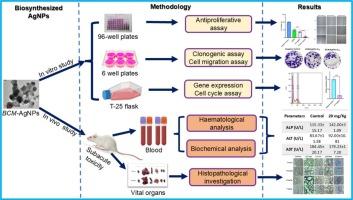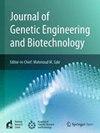In vitro antiproliferative effects of green synthesized silver nanoparticles from Brassica carinata microgreens on DU-145 prostate cancer cells and In vivo safety assessment
IF 2.8
Q3 Biochemistry, Genetics and Molecular Biology
Journal of Genetic Engineering and Biotechnology
Pub Date : 2025-09-19
DOI:10.1016/j.jgeb.2025.100552
引用次数: 0
Abstract
Background
Prostate cancer ranks among the most lethal malignancies affecting men globally. Conventional therapeutic approaches for this disease encounter limitations due to adverse side effects and the emergence of drug resistance, making its management challenging. Green-synthesized silver nanoparticles (AgNPs) have emerged as an attractive alternative to address the shortcomings of existing anticancer treatments.
Objective
This study was undertaken to evaluate the anticancer potential and safety profile of BCM-AgNPs, focusing on DU-145 inhibition and sub-acute toxicity in Wistar rats.
Methods
Previously synthesized Brassica carinata microgreen silver nanoparticles (BCM-AgNPs) alongside Brassica carinata microgreen crude extract (BCME) were used. The antiproliferative activity was investigated through the MTT assay on DU-145 prostate cancer cells and normal Vero E6 cells to determine the IC50 and CC50. Subsequently, a series of bioassays, including cell migration assays, clonogenic assays, cell cycle assays, and DNA fragmentation assays, were conducted. Furthermore, RT-qPCR was performed to delineate the molecular mechanism of BCM-AgNPs on DU-145 cells. Finally, a subacute toxicity study was carried out to assess the safety of BCM-AgNPs.
Results
Both BCM-AgNPs and BCME exhibited potent antiproliferative activity against DU-145 cells with an IC50 of 33.47 μg/mL and 46.25 μg/mL, respectively, while sparing normal Vero E6 cells with selectivity indices of 3.50 for BCM-AgNPs and 4.62 for BCME. BCM-AgNPs demonstrated anti-migratory effects and hindered colony formation in DU-145 cells. They further induced S-phase cell cycle arrest through DNA fragmentation. RT-qPCR analysis revealed the upregulation of pro-apoptotic genes and the downregulation of genes involved in cell survival and proliferation pathways. BCM-AgNPs showed no toxicity in Wistar rats during 28-day oral administration.
Conclusion
This study demonstrates for the first time the selective and prominent antiproliferative effects of BCM-AgNPs against DU-145, as well as their safety and biocompatibility, underscoring their potential as a promising candidate for anticancer therapy.

绿合成银纳米颗粒对DU-145前列腺癌细胞的体外抗增殖作用及体内安全性评价
前列腺癌是影响全球男性的最致命的恶性肿瘤之一。由于不良副作用和耐药性的出现,这种疾病的传统治疗方法受到限制,使其管理具有挑战性。绿色合成的银纳米颗粒(AgNPs)已经成为解决现有抗癌治疗缺点的一个有吸引力的替代方案。目的评价BCM-AgNPs的抗癌潜力和安全性,重点研究其对DU-145的抑制作用和对Wistar大鼠的亚急性毒性。方法采用前人合成的芸苔微绿银纳米颗粒(BCM-AgNPs)和芸苔微绿粗提物(BCME)。采用MTT法测定DU-145前列腺癌细胞和正常Vero E6细胞的IC50和CC50,研究其抗增殖活性。随后,进行了一系列生物测定,包括细胞迁移测定、克隆生成测定、细胞周期测定和DNA片段化测定。此外,RT-qPCR方法进一步揭示了BCM-AgNPs作用于DU-145细胞的分子机制。最后,进行了亚急性毒性研究,以评估BCM-AgNPs的安全性。结果BCM-AgNPs和BCME对DU-145细胞均有较强的抑制活性,IC50分别为33.47 μg/mL和46.25 μg/mL,而对正常Vero E6细胞均有抑制作用,BCM-AgNPs的选择性指数为3.50,BCME的选择性指数为4.62。BCM-AgNPs在DU-145细胞中具有抗迁移作用,并能抑制集落形成。他们进一步通过DNA断裂诱导s期细胞周期阻滞。RT-qPCR分析显示,促凋亡基因上调,参与细胞存活和增殖途径的基因下调。BCM-AgNPs对Wistar大鼠口服28天无毒性。结论本研究首次证明了BCM-AgNPs对DU-145的选择性和显著的抗增殖作用,以及它们的安全性和生物相容性,强调了它们作为抗癌治疗的潜在候选药物的潜力。
本文章由计算机程序翻译,如有差异,请以英文原文为准。
求助全文
约1分钟内获得全文
求助全文
来源期刊

Journal of Genetic Engineering and Biotechnology
Biochemistry, Genetics and Molecular Biology-Biotechnology
CiteScore
5.70
自引率
5.70%
发文量
159
审稿时长
16 weeks
期刊介绍:
Journal of genetic engineering and biotechnology is devoted to rapid publication of full-length research papers that leads to significant contribution in advancing knowledge in genetic engineering and biotechnology and provide novel perspectives in this research area. JGEB includes all major themes related to genetic engineering and recombinant DNA. The area of interest of JGEB includes but not restricted to: •Plant genetics •Animal genetics •Bacterial enzymes •Agricultural Biotechnology, •Biochemistry, •Biophysics, •Bioinformatics, •Environmental Biotechnology, •Industrial Biotechnology, •Microbial biotechnology, •Medical Biotechnology, •Bioenergy, Biosafety, •Biosecurity, •Bioethics, •GMOS, •Genomic, •Proteomic JGEB accepts
 求助内容:
求助内容: 应助结果提醒方式:
应助结果提醒方式:


